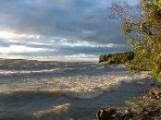Franklin beach named for Arctic hero - some history
Summer beach haven named for Arctic hero
Blast from the Past
Franklin Beach has been a summer haven for suffering urbanites since the late 1800s. The water is warm and inviting, the breeze off the lake refreshing and the view spectacular.
It's ironic, therefore, that this summer playground should be named in honour of a tragedy in the frigid cold of the Arctic.
Few people realize that Franklin Beach was named in memory of Sir John Franklin, after he and his crew went missing in the numbingly cold waters of Canada in 1845.
The story of Georgina's connection to this ill-fated adventurer reveals several little-known facets of local lore.
Sir John Franklin was born in 1786 and entered the Royal Navy at age 14. A natural explorer, he served under his cousin Matthew Flinders on an 1801-03 coastal survey of Australia and was second in command of an Arctic cruise in 1818. During his first journey into Canada's north in 1818-21, Franklin's party surveyed the western shores of Hudson's Bay to the Arctic Ocean.
It was during this exploration a life-long obsession with finding the near-legendary Northwest Passage to the Pacific took root. It was an obsession that led to great acclaim, but would eventually lead to his demise.
All that was years away and far from Franklin's mind when he set out on a second expedition in 1825. The initial leg in this journey saw he and his men journey up the Holland River and enter Cook's Bay near the southwest corner of Georgina.
From there, they rowed in batteauxs (large rowboats) to Barrie, over the Nine-Mile Portage the Nottawasaga River, and then out into Lake Huron. From here, they headed north on an epic adventure.
Sir John Franklin's second Arctic expedition proved even more successful than the first. He and his men surveyed 1,260 miles of northwestern North America's coastline, from the Mackenzie River to Point Beechey in Alaska.
In so doing, he proved the existence of the Northwest Passage. For his achievement Franklin would be knighted.
Encouraged by these successes, Sir John planned a maritime crossing of the Northwest Passage to determine its feasibility as a trade route to the Orient.
If it was indeed navigable, months could be shaved off the voyage between Europe and Asia.
It was 20 years before he could get the necessary backing, but in May of 1845 he set sail with two ships. Nothing more was ever heard from him. Mr. Franklin and his crew perished in the Arctic.
Franklin was a national hero at the time and his latest voyage caught the public's imagination. People in Britain and Canada were shaken by the tragedy. It was during this period of mourning Franklin Beach was named, a sort of monument to the fallen explorer.
But beyond his having passed through Cook's Bay in 1825, there was another connection between Sir John Franklin and Georgina.
It seems there may have been some familiarity between Susan Sibbald, of Sibbald's Point and Eildon Hall fame, and the Franklins.
When Mrs. Sibbald sought donations from friends in England for construction of St. James Anglican Church (adjacent to present day Sibbald Point Provincial Park), among those who responded was the widow of Sir John.
She presented church trustees with a bell to commemorate her husband's crossing of Lake Simcoe 30 years earlier.
That bell is still there.




2 Comments:
Thanks, I've recently been searching for details regarding electronic cigarette promotion for ages and yours is the best I've ρositiοned ѕo far.
Also visit my wеb site :: green smoke flavor reviews
Do you mind if I quote a couple of your articles as long as I provide
credit and sources back to your webpage? My website
is in the very same niche as yours and my visitors would genuinely benefit from a lot of the information you present here.
Please let me know if this okay with you. Thanks!
Also visit my blog post :: ecigaret ()
Post a Comment
<< Home